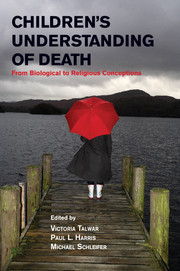Book contents
- Frontmatter
- Contents
- List of Figures and Table
- List of Contributors
- Preface and Acknowledgments
- 1 Death, Ancestors, and the Living Dead: Learning without Teaching in Madagascar
- 2 Death in Spain, Madagascar, and Beyond
- 3 Ambivalent Teaching and Painful Learning: Mastering the Facts of Life (?)
- 4 Death in the Lives of Children
- 5 Talking to Children about Death in Educational Settings
- 6 Responsible Believing
- 7 Thoughts and Feelings: Children and William James Have It Right!
- 8 How the Law Constructs Its Understanding of Death
- Index
- References
4 - Death in the Lives of Children
Published online by Cambridge University Press: 03 May 2011
- Frontmatter
- Contents
- List of Figures and Table
- List of Contributors
- Preface and Acknowledgments
- 1 Death, Ancestors, and the Living Dead: Learning without Teaching in Madagascar
- 2 Death in Spain, Madagascar, and Beyond
- 3 Ambivalent Teaching and Painful Learning: Mastering the Facts of Life (?)
- 4 Death in the Lives of Children
- 5 Talking to Children about Death in Educational Settings
- 6 Responsible Believing
- 7 Thoughts and Feelings: Children and William James Have It Right!
- 8 How the Law Constructs Its Understanding of Death
- Index
- References
Summary
Childhood bereavement comprises as many different experiences as there are children who are bereaved. The HIV/AIDS epidemic has had a tremendous impact on the number and experiences of bereaved children. Around the world, 13–15 million children have been orphaned by HIV/AIDS (UNAIDS 2009; Wessner 2009). In Africa, more than 12 million children are orphans due to HIV/AIDS. Unprecedented numbers of children are being raised by grandparents, and 13.5% of older people are living with their grandchildren, though not their children (Cheng & Siankam, 2009). Researchers have projected that one-third of children in Africa will be orphaned due to AIDS by 2010 (Wessner, 2009). The HIV/AIDS epidemic has worldwide implications, though there are tremendous geographic differences in the effects of HIV/AIDS. Regardless, HIV/AIDS does not affect a majority of children in the world.
Children experience the deaths of parents, siblings, or friends. Children are affected by what they see on television, whether in cartoons, on adult television shows, or on the news. Death is even a surprisingly common theme in Disney movies (Cox, Garrett, & Graham, 2005). When there is an international disaster such as the bombings in Mumbai (November 2008), the 2004 Madrid train bombings, or the September 11, 2001, hijackings and attacks, the events and their aftermaths are played and replayed. Children exposed to these events absorb them or not. They have an important reaction to them or not.
- Type
- Chapter
- Information
- Children's Understanding of DeathFrom Biological to Religious Conceptions, pp. 61 - 97Publisher: Cambridge University PressPrint publication year: 2011
References
- 4
- Cited by

